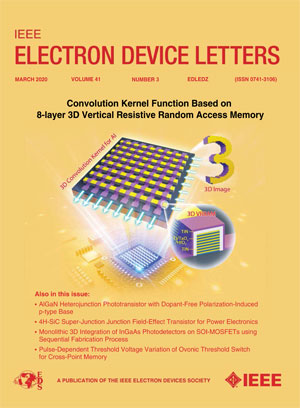使用新开发的带有双掺杂 SRO 中间层的 PLZT 电容器的高可靠性 4 Mb FeRAM
IF 4.1
2区 工程技术
Q2 ENGINEERING, ELECTRICAL & ELECTRONIC
引用次数: 0
摘要
我们成功开发了一种掺杂镧(La)的Pb(Zr,Ti)O $_{\\textbf {3}}$(PLZT)基铁电随机存取存储器(FeRAM),该存储器采用了一种新开发的铁电电容器(FC),该电容器采用了掺铋(Bi)的SrRuO $_{\\textbf {3}}$(B-SRO),旨在改善FC的电气性能和可靠性。溅射沉积的 SrRuO $_{\oldsymbol {\textbf {3}}$通常用作金属电极和铁电层之间的中间层以改善 FC 特性,但由于 SRO 的原子密度较低,通常仅为 85%,因此并不一定能带来良好的电学特性。为了解决这个问题,我们采用了原子密度高达 95% 的 B-SRO 靶材沉积的 B-SRO 中间层。与不使用 B-SRO 的 FC 相比,使用 B-SRO 的 FC 在电气性能、耐久性(90°C 时为 $\gt 10^{\boldsymbol {textbf{14}}$)和保持率(125°C 时约为 10 年)方面都有显著改善。基于 JESD22-A108 标准的可靠性测试证实,我们的 4Mb FeRAM 具有高度可靠性和商业可用性。本文章由计算机程序翻译,如有差异,请以英文原文为准。
Highly Reliable 4 Mb FeRAM Using a Newly Developed PLZT Capacitor With a Bi-Doped SRO Interlayer
We successfully developed a lanthanum (La)-doped Pb(Zr,Ti)O
$_{\boldsymbol {\textbf {3}}}$
(PLZT)-based ferroelectric random access memory (FeRAM) with a newly developed ferroelectric capacitor (FC) employing bismuth (Bi)-doped SrRuO
$_{\boldsymbol {\textbf {3}}}$
(B-SRO), aiming to improve the electrical properties and reliability of the FC. Sputter-deposited SrRuO
$_{\boldsymbol {\textbf {3}}}$
, commonly used as an interlayer between the metal electrode and ferroelectric layers to improve FC characteristics, does not necessarily result in good electrical properties due to the low atomic density of SRO, typically up to 85%. To address this, we employed a B-SRO interlayer deposited by a B-SRO target with an atomic density up to 95%. FCs utilizing B-SRO exhibit significantly better electrical properties, endurance (
$\gt 10^{\boldsymbol {\textbf {14}}}$
at 90°C), and retention (approximately 10 years at 125°C) compared to FCs without B-SRO. Reliability tests based on JESD22-A108 standards, confirm that our 4Mb FeRAM with B-SRO is highly reliable and commercially available.
求助全文
通过发布文献求助,成功后即可免费获取论文全文。
去求助
来源期刊

IEEE Electron Device Letters
工程技术-工程:电子与电气
CiteScore
8.20
自引率
10.20%
发文量
551
审稿时长
1.4 months
期刊介绍:
IEEE Electron Device Letters publishes original and significant contributions relating to the theory, modeling, design, performance and reliability of electron and ion integrated circuit devices and interconnects, involving insulators, metals, organic materials, micro-plasmas, semiconductors, quantum-effect structures, vacuum devices, and emerging materials with applications in bioelectronics, biomedical electronics, computation, communications, displays, microelectromechanics, imaging, micro-actuators, nanoelectronics, optoelectronics, photovoltaics, power ICs and micro-sensors.
 求助内容:
求助内容: 应助结果提醒方式:
应助结果提醒方式:


